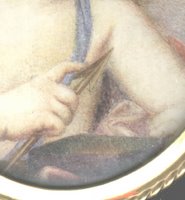
 Traditional Miniature Collections
Traditional Miniature CollectionsAlthough decorative miniatures are generally outside the scope of the collection, one has been shown here to illustrate the use of a miniature portrait, as a love token. The cherub is holding an arrow and a miniature portrait in a rectangular frame.
Traditionally, the best miniature collections are formed by seeking examples of 16C and 17C miniatures by the top British and European artists and then accepting into such collections, representative examples of the very best 18c and 19C artists from Britain and Europe.
By its nature, that method of collecting is very expensive as, on the one hand, 16C and 17C miniatures are scarce, many already being in museums and on the other hand, their scarcity makes them very expensive. Thus they tend to be the preserve of very wealthy collectors.
Nevertheless, if you are seeking more information on the very early history of miniatures see The Origin of the Portrait Miniature and Portrait miniature - Wikipedia, the free encyclopedia, also "Surrounded with Brilliants": Miniature portraits in Eighteenth ...
Focus of this Collection
This collection has been formed from the opposite direction, noting that the early 20C artists are now as far removed from us, as some more famous artists: Cosway, Plimer, and Engleheart, were to Dr Williamson when he wrote their biographies 100 years ago.
The focus is in two less popular areas; American miniatures and 20C miniatures. Accordingly, American and 20C miniatures are the prime interest, with examples of earlier British and European miniatures being acquired only if they represent advantageous buying.
Thus the exhibition does not represent the rarest of early portrait miniatures. These can range upward in value from $50,000 to $200,000, or even more, the record being over $1,000,000. As such they are unlikely to be found by the average collector.
Instead this exhibition displays the type of miniatures the average collector is much more likely to come across and aims to spread knowledge of lesser known artists. As time passes, there is an increasing emphasis on named sitters. This enables a sitter to be researched and information about them made available for visitors interested in genealogical research.
Also included are examples from countries of origin not usually encountered, such as Argentina, Chile, Brazil, Australia, and Canada. There is a wide range of portrait miniatures from America, Britain, and Europe. They were painted during the period from around 1700 up to the time of World War II.
Rarity, Uniqueness, and History
Miniature portraits are each unique artworks which are rarely displayed outside major art museums. Despite the "affordable" focus of this collection, there are miniatures by artists whose work is displayed in the major art museums and collections around the world, including the Smithsonian, the Louvre, the Hermitage, the Metropolitan, the Victoria and Albert, the British and Dutch Royal Collections, and various National Portrait Galleries such as the United States, England, and Scotland. Such major art museum representation would be impossible for a private collector to achieve when collecting in any other branch of original art and makes miniature collecting special.
The books listed in the comprehensive Bibliography include many books detailing the history of miniatures. Many miniatures held hair of a loved one and there is a good discussion on sentimental jewelry by Davida Tenenbaum Deutsch in The Magazine Antiques for April 1999, see Jewelry for mourning, love, and fancy, 1770-1830 Much of Deutsch's own portrait miniature collection is illustrated in the book "Love and Loss" by Robin Jaffe Frank.
No comments:
Post a Comment